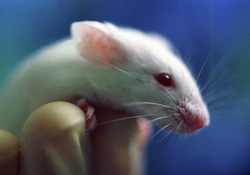
hi bloggers......
LONDON: A team of neurobiologists led by an Indian-origin scientist has claimed to have created mice that can 'smell' light — a potent new tool that could help researchers better understand the neural basis of olfaction or the sense of smell. The research, published in journal 'Nature Neuroscience' , has implications for the future study of smell and of complex perception systems that do not lend themselves to easy study with traditional methods.
"It makes intuitive sense to use odours to study smell," said Venkatesh N Murthy, professor of molecular and cellular biology at Harvard University. "However, odours are so chemically complex that it is extremely difficult to isolate the neural circuits underlying smell that way," he said. For their study, Murthy and his colleagues at Harvard and Cold Spring Harbor Laboratory used light instead, applying the infant field of optogenetics to the question of how cells in the brain differentiate between odours.
Optogenetic techniques integrate light-reactive proteins into systems that usually sense inputs other than light. Murthy and his team integrated these proteins called channelrhodopsins into the olfactory systems of mice, creating animals in which "smell pathways were activated not by odours, but rather by light" . "In order to tease apart how the brain perceives differences in odours, it seemed most reasonable to look at the patterns of activation in the brain," Murthy said.
"But it is hard to trace these patterns using olfactory stimuli, since odours are very diverse and often quite subtle. So we asked: What if we make the nose act like a retina?" With the optogenetically engineered animal, the scientists were able to characterise the patterns of activation in the olfactory bulb — the brain region that receives information directly from the nose. Because light input can easily be controlled , they were able to design a series of experiments stimulating specific sensory neurons in the nose and looking at patterns of activation downstream in olfactory bulb.
"The first question was how processing is organised, and how similar inputs are processed by adjacent cells in brain," Murthy said. But it turns out that spatial organisation of olfactory information in brain doesn't fully explain our ability to sense odours, he added. The temporal organisation of olfactory information sheds additional light on how we perceive odours.
Read more:
Now, mice that can 'smell' light - The Times of India http://timesofindia.indiatimes.com/home/science/Now-mice-that-can-smell-light/articleshow/6766640.cms#ixzz12h9a2IMb
LONDON: A team of neurobiologists led by an Indian-origin scientist has claimed to have created mice that can 'smell' light — a potent new tool that could help researchers better understand the neural basis of olfaction or the sense of smell. The research, published in journal 'Nature Neuroscience' , has implications for the future study of smell and of complex perception systems that do not lend themselves to easy study with traditional methods.
"It makes intuitive sense to use odours to study smell," said Venkatesh N Murthy, professor of molecular and cellular biology at Harvard University. "However, odours are so chemically complex that it is extremely difficult to isolate the neural circuits underlying smell that way," he said. For their study, Murthy and his colleagues at Harvard and Cold Spring Harbor Laboratory used light instead, applying the infant field of optogenetics to the question of how cells in the brain differentiate between odours.
Optogenetic techniques integrate light-reactive proteins into systems that usually sense inputs other than light. Murthy and his team integrated these proteins called channelrhodopsins into the olfactory systems of mice, creating animals in which "smell pathways were activated not by odours, but rather by light" . "In order to tease apart how the brain perceives differences in odours, it seemed most reasonable to look at the patterns of activation in the brain," Murthy said.
"But it is hard to trace these patterns using olfactory stimuli, since odours are very diverse and often quite subtle. So we asked: What if we make the nose act like a retina?" With the optogenetically engineered animal, the scientists were able to characterise the patterns of activation in the olfactory bulb — the brain region that receives information directly from the nose. Because light input can easily be controlled , they were able to design a series of experiments stimulating specific sensory neurons in the nose and looking at patterns of activation downstream in olfactory bulb.
"The first question was how processing is organised, and how similar inputs are processed by adjacent cells in brain," Murthy said. But it turns out that spatial organisation of olfactory information in brain doesn't fully explain our ability to sense odours, he added. The temporal organisation of olfactory information sheds additional light on how we perceive odours.
Read more:
Now, mice that can 'smell' light - The Times of India http://timesofindia.indiatimes.com/home/science/Now-mice-that-can-smell-light/articleshow/6766640.cms#ixzz12h9a2IMb


 RSS Feed
RSS Feed